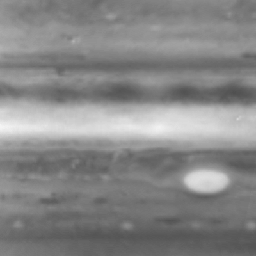Jupiter's high-altitude clouds are seen in this brief movie made from seven frames taken by the narrow-angle camera of NASA's Cassini spacecraft. This is the first time a movie sequence of Jupiter has been made that illustrates the motions of the high-altitude clouds on a global scale.
The images were taken at a wavelength that is absorbed by methane, one chemical in Jupiter's lower clouds. So, dark areas are relatively free of high clouds, and the camera sees through to the methane in a lower level. Bright areas are places with high, thick clouds that shield the methane below.
Jupiter's equator and Great Red Spot are covered with high-altitude, hazy clouds.
The movie covers the time period between Oct. 1 and Oct. 5, 2000, latitudes from 50 degrees north to 50 degrees south, and a 100-degree sweep of longitude. Those factors were the same for a Cassini movie of cloud motions previously released (PIA02829), but that movie used frames taken through a blue filter, which showed deeper cloud levels and sharper detail. Features in this methane-filter movie appear more diffuse.
Among the nearly stationary features are the Red Spot and some bright ovals at mid-latitudes in both hemispheres. These are anticyclonic (counter-clockwise rotating) storms. They are bright in the methane band because of their high clouds associated with rising gas. They behave differently from terrestrial cyclones, which swirl in the opposite direction. The mechanism making the Red Spot and similar spots stable apparently has no similarity to the mechanism which feeds terrestrial cyclones.
Some small-scale features are fascinating because of their brightness fluctuations. Such fluctuations observed in the methane band are probably caused by strong vertical motions, which form clouds rapidly, as in Earth's thunderstorms. Near the upper left corner in this movie, a number of smaller clouds appear to circulate counterclockwise around a dark spot, and these clouds fluctuate in brightness, so they may be candidates for lightning storms.
A pattern of lighter areas between darker patches can be seen in the darkest band a little north of the bright equatorial region. This may be tied to a wave-like temperature variation across the planet. If confirmed, this would be the first time such large-scale stratospheric temperature waves have been visibly linked to variations in haze thickness.
Cassini is a cooperative project of NASA, the European Space Agency and the Italian Space Agency. The Jet Propulsion Laboratory, a division of the California Institute of Technology in Pasadena, manages the Cassini mission for NASA's Office of Space Science, Washington, D.C.

 Planetary Data System
Planetary Data System












